
Prostanthera ovalifolia, commonly known as the oval-leaf mintbush or purple mintbush, is a species of flowering plant in the family Lamiaceae and is endemic to south-eastern continental Australia. It is an erect shrub with egg-shaped leaves and groups of mauve to deep blue-purple flowers arranged in groups at the ends of branchlets.

Prostanthera magnifica, commonly known as magnificent prostanthera, is a species of flowering plant in the family Lamiaceae and is endemic to Western Australia. It is a slender to spreading, erect shrub that has hairy stems, elliptical to narrow egg-shaped leaves and pale mauve or pale blue to pink flowers with prominent dark mauve to purple sepals.

Prostanthera stenophylla is a species of flowering plant in the family Lamiaceae and is endemic to Wollemi National Park in New South Wales. It is an erect, slender, aromatic shrub with hairy, oblong leaves and small groups of pale bluish mauve to violet flowers.
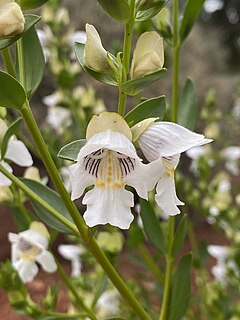
Prostanthera striatiflora, commonly known as jockey's cap, striated mintbush or striped mintbush, is a species of flowering plant that is endemic to the more arid areas of Australia. It is an erect, aromatic shrub with narrow egg-shaped to narrow elliptic leaves and white flowers with purple lines inside the petal tube.
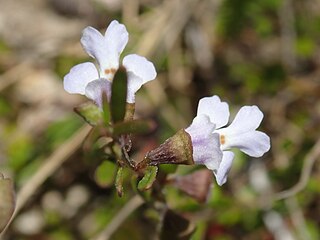
Prostanthera junonis, commonly known as Somersby mintbush, is a species of flowering plant in the family Lamiaceae and is endemic to the Central Coast of New South Wales. It is a low, straggling shrub with hairy, egg-shaped leaves and purple to mauve flowers.

Prostanthera ammophila, commonly known as sand mintbush, is a species of flowering plant in the family Lamiaceae and is endemic to southern areas of South Australia. It is an erect to spreading shrub with egg-shaped to narrow elliptical leaves and white and purple to mauve flowers with yellow spots inside.

Prostanthera behriana, commonly known as tall mintbush, is a species of flowering plant in the family Lamiaceae and is endemic to the south-east of South Australia. It is an erect to straggling shrub with egg-shaped leaves and white, pale blue, pale violet or purplish white flowers with red-brown spots or purple streaks inside.
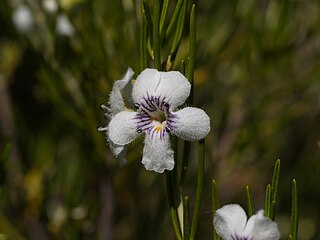
Prostanthera campbellii is a species of flowering plant in the family Lamiaceae and is endemic to the south-west of Western Australia. It is an erect shrub with linear leaves and white to cream-coloured flowers with purple striations.

Prostanthera canaliculata is a species of flowering plant in the family Lamiaceae and is endemic to the south-west of Western Australia. It is a small, erect shrub with hairy branchlets, narrow egg-shaped to narrow elliptical leaves and pale blue or pale violet to white flowers with no markings.
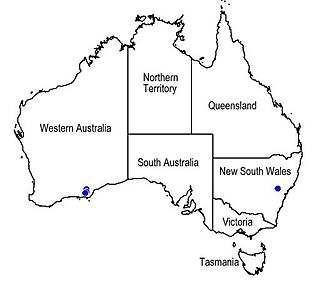
Prostanthera carrickiana, commonly known as Carrick's mintbush, is a species of flowering plant in the family Lamiaceae and is endemic to a restricted area in the south-west of Western Australia. It is an erect shrub with hairy branchlets, elliptical leaves pinkish-red flowers.

Prostanthera chlorantha, commonly known as green mintbush, is a species of flowering plant in the family Lamiaceae and is endemic to the south-east of South Australia. It is a small shrub with small, broadly egg-shaped to round leaves and mauve, bluish green, or greenish red to greenish yellow flowers with a pink tinge.

Prostanthera eckersleyana, commonly known as crinkly mintbush, is a species of flowering plant in the family Lamiaceae and is endemic to the south-west of Western Australia. It is an erect or spreading shrub with sticky, hairy branchlets, egg-shaped to elliptical leaves and blue, mauve to purple or violet flowers with maroon spots inside the petal tube.
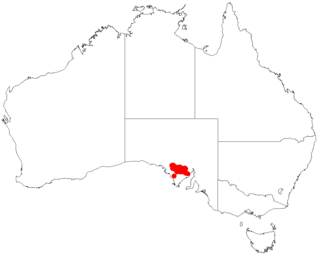
Prostanthera florifera, commonly known as Gawler Ranges mintbush, is a species of flowering plant in the family Lamiaceae and is endemic to the Eyre Peninsula in South Australia. It is a small shrub with densely hairy branches, thick, linear to narrow oblong leaves, and pinkish-red flowers that are pale pink with pinkish-red blotches inside the petal tube.

Prostanthera incurvata is a species of flowering plant in the family Lamiaceae and is endemic to the inland of Western Australia. It is a small, erect shrub with hairy branches, narrow oblong to narrow egg-shaped leaves with the narrower end towards the base, and pink to red, sometimes yellow flowers.

Prostanthera nanophylla is a species of flowering plant in the family Lamiaceae and is endemic to Western Australia. It is a small shrub with hairy branches, egg-shaped to elliptic or narrow oblong leaves and mauve or blue to white flowers with dull brown, maroon or purple spots.
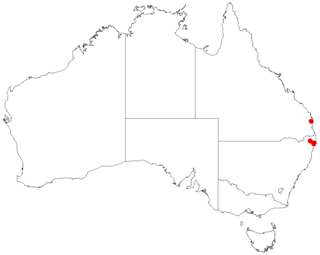
Prostanthera palustris, commonly known as swamp mint-bush, is a species of flowering plant in the family Lamiaceae and is endemic to a restricted area of New South Wales. It is a low, spreading, weak shrub with spatula-shaped leaves and pale mauve and white flowers with yellow spots in the petal tube.
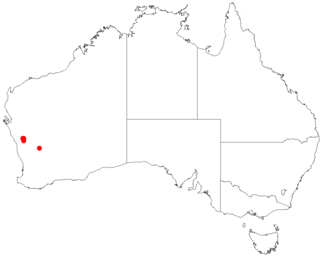
Prostanthera pedicellata is a species of flowering plant in the family Lamiaceae and is endemic to a restricted area of Western Australia. It is a small shrub with densely glandular branches, egg-shaped to oval leaves and red flowers.

Prostanthera petrophila is a species of flowering plant in the family Lamiaceae and is endemic to Western Australia. It is a spreading shrub with densely hairy branches, narrow egg-shaped leaves with the narrower end towards the base and white flowers with violet striations in the petal tube.

Prostanthera scutata is a species of flowering plant in the family Lamiaceae and is endemic to Western Australia. It is a small, erect, compact shrub with densely hairy branches, elliptic to narrow elliptic leaves and pale blue or faintly violet flowers.

Prostanthera sericea, commonly known as silky mintbush or walyuwalyu, is a species of flowering plant in the family Lamiaceae and is endemic to inland Australia. It is an erect shrub with hairy branches, cylindrical leaves and white flowers with mauve or purple streaks.






















